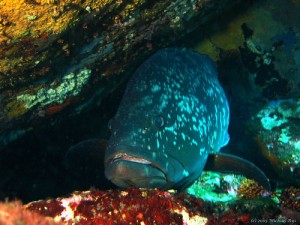- The Gulf of Mexico is home to many commercially valuable fisheries species, including stone crab, shrimp, snapper, and grouper.
- Groupers are a type of fish called serranids, and are members of the family Serranidae. There are many species of grouper.
- They are teleosts, a group of fish identified by their stout bodies and large mouths.
- The goliath grouper is the largest of the groupers and can grow up to 800 lbs.
- Groupers do not swim quickly over long distances. Instead, they hover under structures and wait for prey to approach. Their mouth and gills form a vacuum, inhaling prey from a few feet away and swallowing it whole.
- Grouper eat smaller fish, octopus, crab, and lobster.
- Groupers are protogynous hermaphrodites, meaning they are born female but transform into males when they reach a certain size. They reproduce by spawning (releasing large quantities of eggs and sperm into the open water) during the summer months.
- The commercial fishing (fishing for profit) of groupers is a multi-million dollar industry in the Gulf of Mexico.
- Grouper is a popular item on seafood menus and attracts many tourists to Florida communities and restaurants, therefore boosting local economies.
- Grouper is also a popular sport fishing target.
- Groupers’ commercial and recreational value makes them one of the most overfished species in the Gulf of Mexico. Overfishing is the harvest of fish from a body of water faster than they can reproduce. It is not sustainable, meaning that the grouper populations will eventually collapse.
- Since the 1950s, grouper populations in the Gulf of Mexico have declined rapidly.
- Recall that groupers morph (change) from female to male when they reach a large size. Fishermen typically harvest large male groupers because they are more valuable than smaller females. This behavior disproportionately removes more males than females from the ecosystem, making it difficult for groupers to reproduce successfully. As a result, grouper do not easily recover from population declines, even when fishing is heavily regulated.
- The damage sustained by overfishing makes it necessary to carefully manage the Gulf’s 15 grouper species.
- The 15 grouper species regulated in the Gulf of Mexico are monitored for population size and reproductive potential (the ability to reproduce and create more fish). Fisherman are allowed to catch a limited number of grouper during limited time periods to ensure protection of the mature adults and promote reproductive success.
- Fishermen are prohibited from harvesting nassau and goliath groupers because their populations have been so extensively overfished that any additional harvest would drive the species to extinction.
- Marine Protected Areas have been established to protect some grouper habitats. Fishing for grouper is forbidden in these areas, which allows grouper to grow and reproduce with less risk of being caught.
- Enforcement challenges threaten the success of grouper fishing regulations and marine protected areas.
- Not all fishermen follow laws and regulations relating to grouper.
- In order to help grouper populations recover successfully, it is necessary for the state of Florida to supervise and enforce the rules that have been established.
Practice Good Stewardship
- When you dine at a restaurant, choose a menu option other than grouper. This reduces the demand for grouper as seafood and will help the populations recover.
- Follow all rules and regulations when you go fishing.
Review Questions
- What is a protogynous hermaphrodite?
- Why are grouper populations in the Gulf of Mexico at risk?
- How can we protect grouper species in the Gulf of Mexico?
Glossary
Commercial Fishing: Capturing fish and other seafood to earn a profit.
Goliath Grouper: The largest of the grouper species; can reach 800 lbs.
Groupers: Fish belonging to the family Serranidae; teleosts.
Marine Protected Area (MPA): An area where natural resources are given greater protection than in the surrounding waters.
Overfishing: The practice of fishing a body of water to a degree that the supply of fish or shellfish is exhausted and the nearby ecological balance is upset; the removal of fish from the water faster than they can reproduce.
Protogynous Hermaphrodite: Any species that is born one sex and changes to the opposite sex at a certain point.
Spawning: The release of many eggs and sperm into open water for the purpose of fertilization and reproduction.
Sport Fishing: Fishing for the purpose of pleasure or competition.
Sustainable: In a manner that will not have long term negative impacts on the environment or population of organisms.
Teleosts: Finfish characterized by stout bodies and large, bony mouths.





